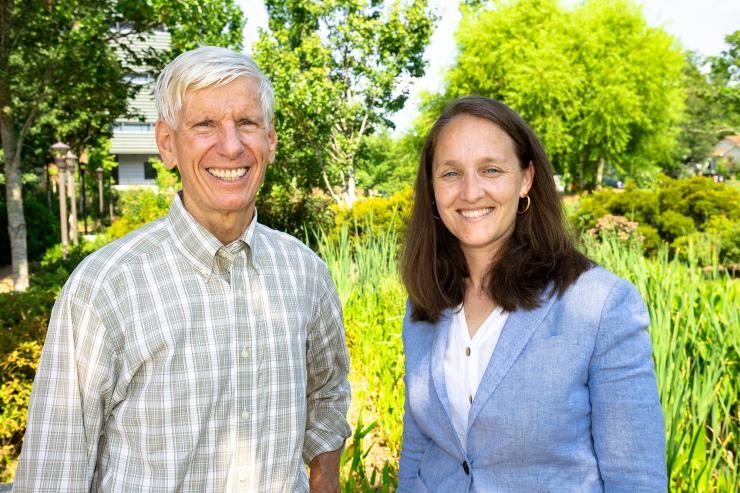
Paul Kohl and Marta Hatzel
Thanks to efforts to combat climate change, many have heard the catchphrase “closing the carbon loop” — a global effort to convert carbon dioxide into something useful to mitigate the damaging effects of pollution on the planet. Another environmental challenge relates not to carbon dioxide but nitrogen. Now, an ambitious plan to close the nitrogen loop is underway, and with it comes the potential to revolutionize agriculture in the U.S. and around the world.
The Georgia Institute of Technology will be part of CASFER, an NSF Engineering Research Center (NSF-ERC), with four other universities. Supported by an initial grant of $26 million from NSF, CASFER seeks to transform the U.S. from nitrogen cycle pollution to a nitrogen circular economy by developing new technologies and programs for capturing, recycling, and producing decarbonized nitrogen-based fertilizers (NBFs). Georgia Tech is joined by Florida Agricultural and Mechanical University, Case Western Reserve University, the Massachusetts Institute of Technology, and Texas Tech University, which will lead the effort and serve as CASFER’s headquarters.
Nitrogen is used in many commercial applications, but one of the most significant uses is in NBFs for growing food. NBFs are put out into fields, but most do not get used — 80% are washed away and wasted, ending up as pollutants in the watershed. With support from NSF, this team of universities will attempt to recover and reuse nitrogen compounds, the principal element in fertilizers.
“By taking pollutants out of the water and converting them for use, we are taking a negative and making a positive out of it,” said Paul Kohl, Regents' Professor and Thomas L. Gossage Chair in the School of Chemical and Biomolecular Engineering (ChBE) and co-lead of the CASFER effort at Georgia Tech, along with Marta Hatzell, associate professor in the George W. Woodruff School of Mechanical Engineering. “This process will both decrease pollution and lower the cost of farming.”
CASFER has three areas of focus it will pursue to achieve its goal. The first involves measuring and analyzing data to identify new opportunities and locations for collecting wasted fertilizer and determining how exactly the fertilizer affects individual environments.
The second area — Kohl and Hatzell’s focus — is the actual collection and separation of nitrogen compounds from the three types of environments where they usually show up: produce farms, livestock farms, and wastewater treatment plants. They will develop specialized separation methods to pull nitrogen pollutants out of the various environments, creating new types of polymer membranes that work to separate and concentrate the compounds into solutions that can be converted for future use. The work will start in the laboratories at Georgia Tech, but later the team will build test beds — portable laboratories the size of small trailers — to test their separation methods on-site.
“All our separations technologies will be modular, electrified, and largely decarbonized,” said Hatzell. “Our overall goal is to design processes that synthesize new or recover used fertilizers from waste at the same or lower price than traditional chemical manufacturing processes.”
The third area is reconverting the concentrated solutions into usable fertilizer. Humans have been making fertilizer the same way for more than 100 years, using an expensive chemical process that requires natural gas — a resource in short supply. CASFER researchers will develop the conversion methods to create new fertilizers and strategies for dispensing it back into fields for growing crops.
“One strength of NSF Engineering Research Centers is their ability to bring interdisciplinary academic teams together in convergent research to identify novel approaches to thorny societal challenges,” said NSF Assistant Director for Engineering Susan Margulies. “With their unique testbeds and industry partners, the centers innovate and translate solutions that are effective and sustainable.”
CASFER is poised to bring about dramatic changes to the agriculture industry. Since the inception of the Engineering Research Centers program in 1985, the NSF has awarded fewer than 100 grants to open ERCs, which are designed to foster innovation and collaboration between industry leaders, government agencies, and institutions of higher education.
“For decades, NSF Engineering Research Centers have transformed technologies and fostered innovations in the United States through bold research, collaborative partnerships, and a deep commitment to inclusion and broadening participation,” said NSF Director Sethuraman Panchanathan. “The new NSF centers will continue the legacy of impacts that improve lives across the nation.”
Looking to the future, universities will launch workforce development efforts like training and education to prepare a new generation of farmers and scientists for work in the nitrogen circular economy.
Georgia Tech researchers involved in the grant include Kohl (Co-Thrust Leader), Andrew Medford, and Joseph Scott from ChBE; Peter Hesketh (Co-Thrust Leader) and Hatzell (Thrust Leader/Co-PI) from the Woodruff School; Mary-Lynn Realff from the School of Materials Science and Engineering; Lizanne DeStefano (EWD Lead) from CEISMC; and Jie Xu and Milad Navaei from the Georgia Tech Research Institute.
Catherine Barzler, catherine.barzler@gatech.edu